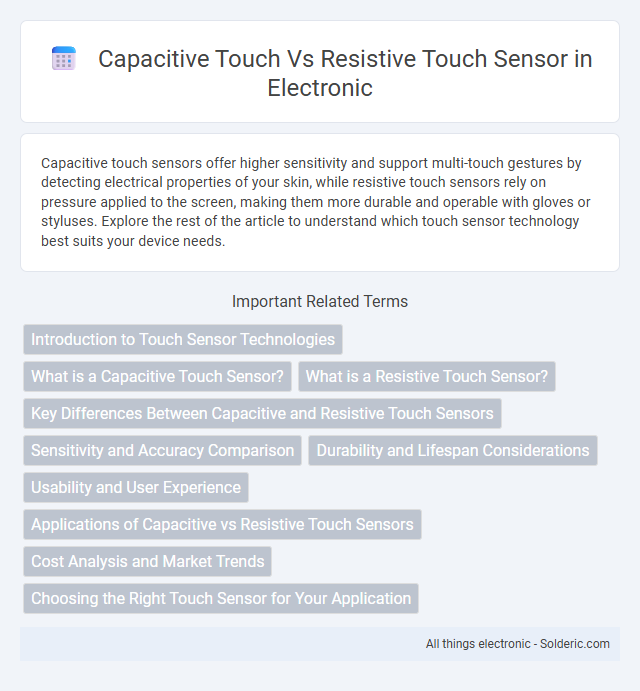Capacitive touch sensors offer higher sensitivity and support multi-touch gestures by detecting electrical properties of your skin, while resistive touch sensors rely on pressure applied to the screen, making them more durable and operable with gloves or styluses. Explore the rest of the article to understand which touch sensor technology best suits your device needs.
Comparison Table
| Feature | Capacitive Touch Sensor | Resistive Touch Sensor |
|---|---|---|
| Working Principle | Detects touch via change in capacitance | Detects touch via pressure causing contact between layers |
| Touch Sensitivity | Highly sensitive to light touch | Requires firm pressure |
| Multi-Touch Support | Supports multi-touch gestures | Generally does not support multi-touch |
| Durability | Scratch-resistant glass surface | Prone to wear due to flexible layers |
| Cost | Higher cost due to advanced technology | Lower cost, simpler design |
| Visibility | Better clarity and brightness | Reduced clarity due to extra layers |
| Environmental Resistance | Less affected by dust and moisture | Can malfunction if exposed to dust or liquids |
| Common Applications | Smartphones, tablets, interactive displays | Industrial controls, GPS devices, medical equipment |
Introduction to Touch Sensor Technologies
Capacitive touch sensors detect touch by measuring changes in the electrostatic field caused by the conductive properties of the human skin, offering high sensitivity and multi-touch capability. Resistive touch sensors operate through pressure applied to flexible layers, allowing input with any object but typically providing lower sensitivity and single-touch functionality. These distinct technologies influence device design choices based on factors like durability, precision, and environmental suitability.
What is a Capacitive Touch Sensor?
A capacitive touch sensor detects touch by measuring changes in an electrostatic field when your finger makes contact with the sensor's surface. It consists of a glass panel coated with a transparent conductor, such as indium tin oxide, which registers the location of the touch based on capacitance variations. Capacitive sensors offer higher accuracy, multi-touch capabilities, and greater durability compared to resistive touch sensors.
What is a Resistive Touch Sensor?
A resistive touch sensor is a type of touchscreen technology that operates by detecting pressure applied to the surface, causing two flexible layers to make contact and register a touch. This sensor is highly accurate in environments where users wear gloves or use styluses, making it ideal for industrial and medical applications. Your choice of a resistive touch sensor ensures reliable performance in conditions where capacitive sensors might struggle due to moisture or dirt.
Key Differences Between Capacitive and Resistive Touch Sensors
Capacitive touch sensors detect touch through the electrical properties of the human body, offering higher sensitivity, multi-touch capability, and superior clarity on glass surfaces. Resistive touch sensors rely on pressure applied to two flexible layers, providing cost-effective input with compatibility for any stylus or gloved finger but lower durability and less accurate touch response. The choice between capacitive and resistive touch technology depends on factors such as environmental conditions, user interface requirements, and cost constraints.
Sensitivity and Accuracy Comparison
Capacitive touch sensors offer higher sensitivity and accuracy due to their reliance on detecting changes in the electrostatic field caused by your finger, allowing for precise multi-touch input and rapid response times. Resistive touch sensors require pressure to register input, resulting in lower sensitivity and less accurate touch detection, often limiting interaction to single points and slower responsiveness. Your choice between the two should consider the need for precision and touch experience in the intended application.
Durability and Lifespan Considerations
Capacitive touch sensors offer superior durability and a longer lifespan due to their solid-state design, which lacks mechanical moving parts prone to wear. Resistive touch sensors, relying on pressure to register input through flexible layers, are more susceptible to damage, wear, and degradation over time. This makes capacitive sensors preferable for high-usage environments, as they maintain sensitivity and functionality longer under continuous use.
Usability and User Experience
Capacitive touch sensors offer superior usability with multi-touch support and higher sensitivity, enhancing Your interaction through smoother gestures and quicker response times. Resistive touch sensors function reliably in diverse environments, including with gloves or styluses, but often require firmer pressure, which can reduce overall user comfort. The choice impacts user experience significantly, as capacitive screens deliver more intuitive navigation while resistive options provide durability in specialized use cases.
Applications of Capacitive vs Resistive Touch Sensors
Capacitive touch sensors dominate modern smartphones, tablets, and interactive kiosks due to their high sensitivity, multi-touch capability, and durability in consumer electronics. Resistive touch sensors are favored in industrial machinery, medical devices, and outdoor equipment where precise input with any object, including gloves or a stylus, is essential under harsh conditions. Your choice between these sensors depends on the application's need for accuracy, environmental resilience, and type of user interaction.
Cost Analysis and Market Trends
Capacitive touch sensors generally have higher initial costs due to their advanced technology and multi-touch capabilities, while resistive touch sensors are more cost-effective and suitable for budget-conscious applications. Market trends indicate increasing adoption of capacitive touch technology in smartphones, tablets, and automotive interfaces driven by consumer demand for durability and enhanced user experience. Your choice between these sensors should consider long-term value, as capacitive sensors are rapidly becoming the industry standard despite higher upfront expenses.
Choosing the Right Touch Sensor for Your Application
Choosing the right touch sensor for your application depends on factors like durability, sensitivity, and cost. Capacitive touch sensors offer higher sensitivity, multi-touch capabilities, and better durability against scratches, making them ideal for smartphones and tablets. Resistive touch sensors provide reliable input with any object or gloved finger, lower cost, and better performance in harsh environments, suitable for industrial equipment and medical devices.
capacitive touch vs resistive touch sensor Infographic

 solderic.com
solderic.com